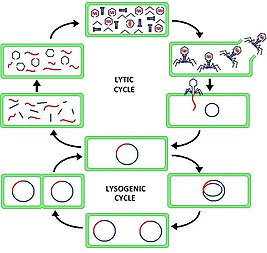
Temperateness (virology)
In virology, temperate refers to the ability of some bacteriophages (notably coliphage λ) to display a lysogenic life cycle. Many (but not all) temperate phages can integrate their genomes into their host bacterium's chromosome, together becoming a lysogen as the phage genome becomes a prophage. A temperate phage is also able to undergo a productive, typically lytic life cycle, where the prophage is expressed, replicates the phage genome, and produces phage progeny, which then leave the bacterium. With phage the term virulent is often used as an antonym to temperate, but more strictly a virulent phage is one that has lost its ability to display lysogeny through mutation rather than a phage lineage with no genetic potential to ever display lysogeny (which more properly would be described as an obligately lytic phage).[1]

Induction of the lytic cycle
At some point, temperate bacteriophages switch from the lysogenic life cycle to the lytic life cycle. This conversion may happen spontaneously, although at very low frequencies (λ displays spontaneous conversion of 10−8 to 10−5 per cell).[2] In the majority of observed switch events, stressors - such as the cell's SOS response (due to DNA damage) or a change in nutrients - induces the switch.[3]

Lysogenic and lytic cycles
Temperate phages can switch between a lytic and lysogenic life cycle. Lytic is more drastic, killing the host whereas lysogenic impacts host cells genetically or physiologically.[4][5][6] Here is a chart on temperate phages that are lytic and lysogenic and how they're related. Lysogeny is characterized by the integration of the phage genome in the host genome.

| Host | Temperate Phages |
|---|---|
| Escherichia coli | E. coli prophage, SUSP1, SUSP2 |
| Salmonella | Fels-2, Enterobacteriaceae |
| Vibrio cholerae | CTX𝜑 |
| Staphylococcus aureus | Staphylococcal phages |
| Clostridium perfringens | Clostridium phage
phiMMP01, vbCpeS-CP51, Staphylococcus phage |

Notes
- ^ Barksdale L, Arden SB (1974). "Persisting bacteriophage infections, lysogeny, and phage conversions". Annual Review of Microbiology. 28: 265–99. doi:10.1146/annurev.mi.28.100174.001405. PMID 4215366.
- ^ Czyz A, Los M, Wrobel B, Wegrzyn G (2001). "Inhibition of spontaneous induction of lambdoid prophages in Escherichia coli cultures: simple procedures with possible biotechnological applications". BMC Biotechnology. 1 (1): 1. doi:10.1186/1472-6750-1-1. PMC 32160. PMID 11316465.
- ^ Howard-Varona C, Hargreaves KR, Abedon ST, Sullivan MB (July 2017). "Lysogeny in nature: mechanisms, impact and ecology of temperate phages". The ISME Journal. 11 (7): 1511–1520. Bibcode:2017ISMEJ..11.1511H. doi:10.1038/ismej.2017.16. PMC 5520141. PMID 28291233.
- ^ Howard-Varona C, Hargreaves KR, Abedon ST, Sullivan MB (July 2017). "Lysogeny in nature: mechanisms, impact and ecology of temperate phages". The ISME Journal. 11 (7): 1511–1520. Bibcode:2017ISMEJ..11.1511H. doi:10.1038/ismej.2017.16. ISSN 1751-7362. PMC 5520141. PMID 28291233.
- ^ Cieślik M, Bagińska N, Jończyk-Matysiak E, Węgrzyn A, Węgrzyn G, Górski A (2021-05-28). "Temperate Bacteriophages—The Powerful Indirect Modulators of Eukaryotic Cells and Immune Functions". Viruses. 13 (6): 1013. doi:10.3390/v13061013. ISSN 1999-4915. PMC 8228536. PMID 34071422.
- ^ Gummalla VS, Zhang Y, Liao YT, Wu VC (2023-02-21). "The Role of Temperate Phages in Bacterial Pathogenicity". Microorganisms. 11 (3): 541. doi:10.3390/microorganisms11030541. ISSN 2076-2607. PMC 10052878. PMID 36985115.

See what we do next...
OR
By submitting your email or phone number, you're giving mschf permission to send you email and/or recurring marketing texts. Data rates may apply. Text stop to cancel, help for help.
Success: You're subscribed now !
